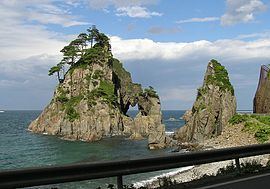Country Japan | Population 35,141 (Sep 2015) | |
 | ||
Weather 0°C, Wind W at 18 km/h, 80% Humidity University Allen International Junior College Points of interest Tatsumiyama Park, Suwa Park, Chosenji | ||
Iwate kenpoku bus bus view bound for kuji station kosode coast kaigan kuji iwate japan
Kuji (久慈市, Kuji-shi) is a city located in Iwate Prefecture, Japan. As of September 2015, the city had an estimated population of 35,141 and a population density of 56.4 persons per km². The total area was `623.50 square kilometres (240.73 sq mi).
Contents
- Iwate kenpoku bus bus view bound for kuji station kosode coast kaigan kuji iwate japan
- Map of Kuji Iwate Prefecture Japan
- Geography
- Neighboring municipalities
- History
- Economy
- Education
- Railway
- Highway
- Port
- Local attractions
- Kuji amber
- Ama divers
- Kokujiyaki
- Kosode Coast
- International relations
- Ties with Franklin
- Ties with Klaipda
- Noted people from Kuji
- References
Map of Kuji, Iwate Prefecture, Japan
Geography
Kuji is located in far north-eastern Iwate Prefecture, bordered by the Pacific Ocean to the east and the Kitakami Mountains to the west. The Kuji River, with a length of 27 km (17 mi) flows through the city from its source at Mount Myōjin.
Neighboring municipalities
History
The area of present-day Kuji was part of ancient Mutsu Province, and has been settled since at least the Jomon period. Amber for the area has been found at archaeological sites dating from the Nara period at the site of Heijo-kyo and Fujiwara-kyo. During the Sengoku period, the area was dominated by various samurai clans before coming under the control of the Nambu clan during the Edo period, who ruled Hachinohe Domain under the Tokugawa shogunate. The area was noted for its production of ironsand, essential in the production of Japanese swords. These deposits were exploited commercially from the Meiji period, but were exhausted by the 1960s.
The town of Kuji was established within Kita-Kunohe District on April 1, 1889. The area was devastated by a 26 metres (85 ft) tsunami in 1896, which killed 789 inhabitants. Kita-Kunohe District and Minami-Kunohe Districts merged to form Kunohe District on April 1, 1897. In January 1926, much of the town was destroyed by a fire which consumed 224 houses. An even larger fire in April 1945 destroyed 950 houses. The modern city was founded on November 3, 1954 with the merger of the towns of Kuji and Osanai with the villages of Samuraihama, Yamane, Natsui, Ube, and Okawame. In April 1983, a fire destroyed 61 homes in the city.
On March 6, 2006, the village of Yamagata (from Kunohe District), was merged into Kuji.
Kuji suffered extensive damage from the earthquake and tsunami, with the tsunami reaching 27 metres (89 ft) in some locations, and the tsunami damage extending 4 kilometres (2.5 mi) inland.A total of 444 houses were destroyed, and 410 houses extensively damaged, but there were only four confirmed fatalities, with two residents missing.
Economy
The local economy is based on agriculture (primarily spinach) and commercial fishing. The area was formerly noted for its production of amber, which remains an important local handicraft.
Education
Kuji has 15 elementary schools, ten middle schools and three high schools, as well as one special education school.
Railway
Highway
Port
Local attractions
For its small size, Kuji boasts a wealth of local specialties and tourist attractions. Most popular and well known of these include Kuji amber, Ama diver women, Kokujiyaki ceramic pottery, and the Kosode Coastline.
Kuji amber
Kuji is one of Japan's largest producers of amber.
Ama divers
Kuji is also known as the Northern Limit of the Ama, female skin divers. Ama dive without breathing aids to depths reaching 10 meters, with the goal of procuring shellfish, seaweed, and pearls. The most acclaimed catch of the Ama is uni, sea urchin and abalone. Due to the long winter and harsh climate of the Tohoku region, Ama diving does not occur further north than Kuji.
Kokujiyaki
Kokujiyaki is a style of ceramic pottery unique to the Kokuji district of Kuji.
Kosode Coast
Kuji is on the northern reaches of the region known as the "Sanriku Coastline," a stretch of the northeastern Japanese coast known for its dramatic rock formations and views. The Kosode Kaigan, named after the local small fishing community in the coastal mountains of Kuji was spotlighted as the location of the popular 2013 NHK morning TV drama Amachan.
International relations
Kuji currently has two sister cities:
Ties with Franklin
In 1960 a sister city bond was established via Mayor Frank S. Records of Franklin, Indiana and Mayor Gyobun Yamauchi, Mayor of Kuji, Japan. A Franklin College graduate and childhood resident of Franklin, Miss Thomasine Allen had traveled to Japan to pursue Christian missionary work. After teaching in various locations in Japan for several years from 1915, she found her way to Kuji, Japan in 1938 and spent the rest of her life in Kuji (with the exception of repatriation during WWII). She dedicated her time to establishing Christian facilities in Kuji including a kindergarten, hospital, church and college. Upon establishment of the sister city relationship, Thomasine Allen was voted by the City Council of Kuji to be an honorary citizen of the city.
Ties with Klaipėda
Partnership between Kuji and Klaipėda began in 1989, one year before the independence of Lithuania, hence becoming the first Lithuanian sister city in Japan. In January 1991, then-Mayor of Kuji Yoshiaki Kuji condemned the military actions of Soviet Union by sending a protest note to the General Secretary of the CPSU Mikhail Gorbachev. The 1995 World Municipalities Congress in Hague recognised Klaipeda’s and Kuji’s cities cooperation as an example to follow. Congress expressed hope that this cooperation will inspire other Lithuania’s and Japan’s cities to expand their partnership.
